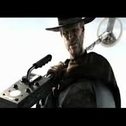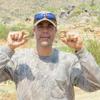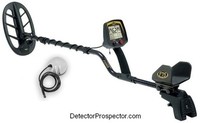
I looked forward to the introduction of the Fisher F75 with great anticipation since the lead engineer behind it was Dave Johnson. Dave has had a hand in many of the best VLF gold detectors ever designed, quite a few of which I have used with great success.
I admit to being put off when I got my first F75. The stupid thing seemed to false constantly when I used it in Anchorage. On top of that there were numerous reports of problems with product quality issues from users on the Internet. It was not meeting my expectations and I sold my first unit in fairly short order to my friend George.
Then George reported how much he liked his F75, the very one I had sold him. Then buddy John got one of the new F75 Limited Edition camouflage models and reported how great it was. Then detector pal Gary told me how much he liked his F75 LE. Obviously I was missing something. So I got an F75 Special Edition, an all black limited edition model with gold trim, which comes with two coils and which has a special Boost Mode for extra depth where it can be used. This unit is rather confusingly being referred to also as the Limited Edition on the Internet. The reality is the only difference between the camo Limited Edition and the all black Special Edition is the paint job.
My first trip in with my new F75 SE was to Moore Creek, Alaska. Moore Creek normally favors pulse induction detectors, but I was pleased to find the F75 handled the tough hot rock environment as well as any VLF detector I have used there, if not better. I got some time to do a little nugget detecting myself, and so looked for an opportunity to use the F75. The airstrip at Moore Creek is made of old tailings, and so has the potential for nuggets. But it also is loaded with trash, so people tend to avoid it. Another person in camp was using a VLF, so I suggested he give the airstrip a go in discrimination mode to sort through the trash and maybe find a nugget. He declined, so I figured what the heck, I'll do it myself.
Usually nugget hunting is done in all metal mode. But I do use discrimination modes a lot, when in trashy areas, or to help with severe hot rocks. I set the F75 up in JE mode and cranked the sensitivity as high as conditions would allow. I used notch 1, discrimination 6, single tone. The unit ran hot and a bit chirpy. I soon discerned that hot rocks were hitting about 16, and concentrated on hits over 16. I dug lots of .22 shell casings, which I was amused to find hit at 22. Plus bullets and aluminum trash. I was right in the middle of the runway when I got a strong signal, and was surprised when a 1/2 ounce nugget popped out of the ground! It also hit right at 22. The next day I hunted with the F75 again, and pulled up two more gold nuggets, each a couple pennyweight each. Needless to say I was very happy with the F75 at this point.
My time at Moore Creek was over and I flew directly over to Ganes Creek, Alaska. Ganes Creek is only 30 miles from Moore Creek, but conditions are far different. It is low mineral ground loaded with ferrous junk, and large gold nuggets. Good ferrous discriminating VLF units are favored there, and so once again I gave the F75 a spin. This time I experimented with the all metal mode. I found I could run with the settings maxed in all metal and yet the unit ran smoother than in disc mode. Better yet the machine is getting maximum audio depth, while the meter continues to operate in discrimination mode.
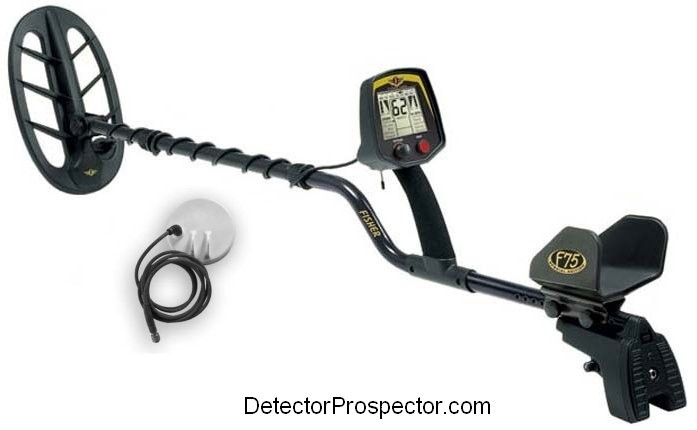
Fisher F75 Special Edition metal detector
This is a rare trait in a detector, offering the best of the all metal and discrimination modes at one time. You hunt by ear, and in cases where the target is shallow enough, you will get a target id. But what got my interest were the targets I heard, but for which there was no target id. These are very deep targets, deeper than units operating in a pure discrimination mode will hear. I waited until an opportunity arose where the other people in the group pounded a particular tailing pile that had just been bulldozed. This tailing pile always produces gold, so people were all over it, giving it their best shot. Finally, nothing was coming out of the ground, so they all wandered off.
I set the F75 up in all metal, and really put my effort into covering every inch to the best of my ability, listening for the faintest whispers. Up came various non-ferrous targets the others has passed over, all beyond discrimination depth. What I did was get a signal, but no target id, then dig off some soil until the target id kicked in. This usually revealed a ferrous target, and I would quit. Or a non-ferrous target, in which case I dug it up. They proved to be various aluminum targets, which anyone looking for gold has to dig
I persevered, and finally got a nice, sweet audio, within no id. I dug down, and still no id. And dug some more, and it kicked in as non-ferrous. And then, at over a foot, another 1/2 nugget appeared, but a much nicer piece than the once I had found at Moore Creek. This one was solid gold and a very attractive nugget. I was pleased to no end. It really makes me feel good when I can go in behind a bunch of good detectorists and still pull up an excellent find. It is impossible not to like a detector that lets me make such a find.
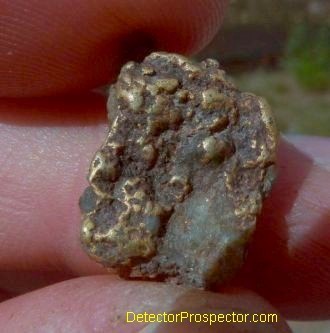
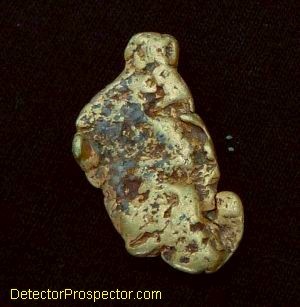
Half ounce Moore Creek gold nugget and half ounce Ganes Creek nugget - both F75 finds
A month later and I found myself in northern California, on my first nugget hunting trip outside Alaska. We were hunting an old hydraulic pit, and I was leaning on the Gold Bug 2 since the gold was very small. But I did give the F75 a spin, to see how small a nugget I could find with it. Unfortunately I did not have my small coil along, so I can't offer an absolute answer to that question. The smaller coils are hotter than the stock coil on small gold. Since all I had was the stock coil, I gave it a try. A little experimentation showed me that the all metal mode hit small gold well, but the audio response is very soft. I found the same test nugget would bang out hard in JE mode cranked up to sensitivity 99, single tone, discrimination at 6. So I went with that.
I hit an area right next to camp and due to the low mineralization the unit ran smooth even though the settings were maxed out. Not something you will see often. I dug shell casing fragments for some time and bits of lead, but that made me happy. If an area is cleaned out, there should not be non-ferrous targets of any sort left in the ground. Then I got a small nugget, my first gold ever from outside Alaska. I have found many pounds of larger gold, but this little nugget was my favorite of the summer just for being from California. It only weighed a few grains. A bit more hunting in the same area turned up its cousin, also only a few grains in weight.
I have to note that a few grains is small indeed. If the F75 is that hot with the stock coil, it should do better yet with a small coil. So there you have it. Large nuggets and small, gold from mineralized ground and in the middle of trashy ground. For versatility the F75 is hard to beat, and it is definitely a very capable prospecting detector. I managed to pay for the detector in just a few days nugget hunting.
I went back to Ganes Creek in 2011, and got gold nuggets every day. The full story is here. The F75 paid for itself and then some!
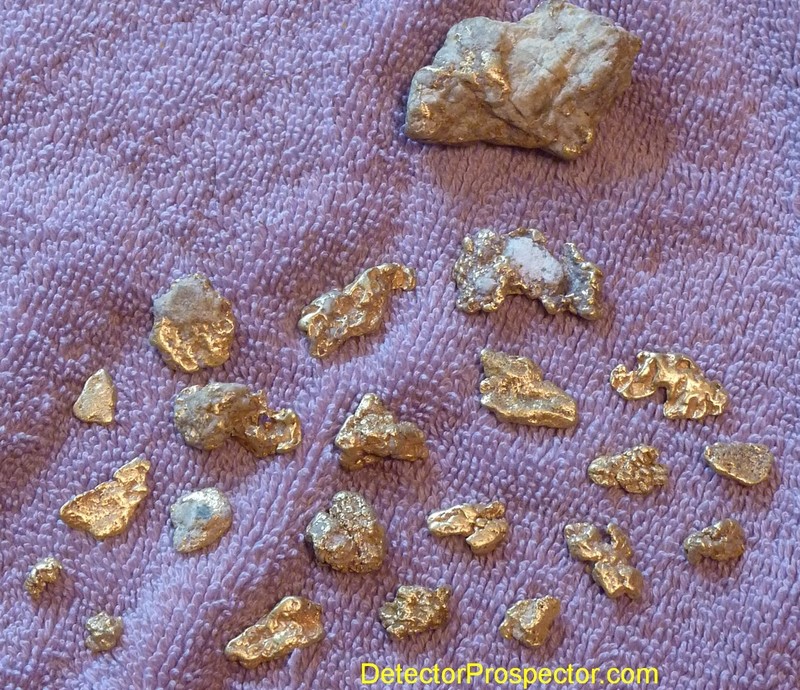
Over three ounces of F75 gold from Ganes Creek
There are a few things about the F75 that I like very much. First and perhaps most important, the weight and balance is superb. I can swing the F75 all day with no risk of arm fatigue. Add to that exceptional battery life. This detector just keeps on going. It comes with a meter cover and control box cover that are perfect for rainy conditions. The small coil is great on small gold. It is a very hot 13 kHz detector. Now, I do not want to go overboard here. The F75 is not as hot on tiny stuff as detectors like the Fisher Gold Bug 2 or White's GMT. It does quite well though for a mid-frequency detector.
I learned a lot at Ganes Creek. I ran in all metal mode. What makes the F75 rather unique is that the meter is always in discriminate mode even when the unit is operating in all metal. All metal gets you max depth and sensitivity. So I would hunt and listen with all settings jacked to the max. Boost all metal sensitivity set to 99. Any audio response is a reason to stop, slow down and examine the signal. If the meter is blank, dig on down until the meter kicks in. If you get solid 15 or lower meter readings repeatedly take a pass and move on. If the target does anything else on the meter (bouncing from high to low) dig that puppy. Most gold reads about 22 but the larger the nugget the higher it can read.
I wish I could get my first week at Ganes back this spring as it was not until week two that I really zeroed in on how the machine works. I consistently was getting small nuggets that most of the other people were leaving behind.
So hunt all metal, hunt by ear, study each target with the meter, and dig anything not 100% bad. This ability to hunt in all metal to get 100% performance allows targets to be found that would be missed in a discriminate mode. The signals that give an audio but no meter reading would not be found if the detector is run in discriminate mode.
If there is a lot of trash or hot rocks running in all metal and examining every target can be overwhelming. At Moore Creek there are so many hot rocks I was better off running in disc and setting the discrimination to knock out the hot rocks.
No machine does it all, but the F75 Special Edition is a detector that I will be using a lot in 2012 because for what it does well it does exceptionally well. What it still does not do well is run quietly in urban areas. The machine is rock solid out in the middle of nowhere but is a chatterbox in town. Still, I like how it feels on my arm and I am convinced I have an edge on the next guy. I can't ask for more than that. And it shows how a detector that I once disliked can end up being one of my favorites.
~ Steve Herschbach
Copyright © 2011 Herschbach Enterprises
-
 1
1



